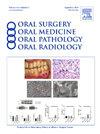多中心基底细胞腺瘤伴浸润性导管病变
IF 1.9
3区 医学
Q2 DENTISTRY, ORAL SURGERY & MEDICINE
Oral Surgery Oral Medicine Oral Pathology Oral Radiology
Pub Date : 2025-07-21
DOI:10.1016/j.oooo.2025.04.056
引用次数: 0
摘要
夹层管病变(idl)是指偶尔与唾液腺肿瘤(如上皮-肌上皮癌和基底细胞腺瘤)相关的夹层管异常增生。这些实体的同时发生导致推测idl可能是某些唾液腺肿瘤的前兆。最近的研究证实了idl及其相关肿瘤之间的分子相似性。我们在此描述一位65岁男性,因左侧腮腺肿块而就诊2年。磁共振造影显示左侧腮腺内有7个明确的肿块。病变表现为不均匀强化,以T2低密度为主。患者的病史为左侧甲状腺腺瘤样结节和40年前治疗过的黑色素瘤。左侧腮腺切除术的组织学检查显示多发界限清晰的上皮增生,其中肿瘤岛显示周围栅栏状的高染核和导管分化灶。在腮腺周围实质内也可见穿插导管灶,偶见浆液腺泡分化,与idl一致。免疫组化分析显示两种人群β -连环蛋白核阳性,Ki-67显示增殖指数约为5%-10%。诊断为多中心基底细胞腺瘤伴浸润导管病变。患者术后1个月无并发症。idl仍然是一组知之甚少的良性唾液腺增生,包括增生、腺瘤和具有两者特征的混合型病变。它们与良性唾液腺肿瘤同时发生,如果误诊为浸润性生长,可能会给诊断带来挑战,并增加恶性肿瘤的可能性。提高对idl的组织病理学和免疫组织化学谱的认识及其与唾液腺肿瘤的潜在同步发生有助于避免此类诊断陷阱。本文章由计算机程序翻译,如有差异,请以英文原文为准。
Multicentric basal cell adenoma with intercalated Duct lesions
Intercalated duct lesions (IDLs) represent abnormal proliferations of the intercalated ducts that are occasionally associated with salivary gland neoplasms, such as epithelial-myoepithelial carcinoma and basal cell adenoma (BCA). The concomitant occurrence of these entities has led to speculation that IDLs may represent a precursor for certain salivary gland neoplasms. This is supported by recent studies that have demonstrated molecular similarities between IDLs and their associated tumors. Herein we describe a 65-year-old male who presented for evaluation of a left parotid mass present for 2 years. An MRI with contrast revealed 7 well-defined masses within the left parotid gland. The lesions demonstrated areas of heterogeneous enhancement with predominantly T2 hypointensity. The patient’s medical history was significant for an adenomatoid nodule of the left thyroid and a distant history of melanoma treated 40 years prior. Histologic examination of the left parotidectomy revealed multiple well-demarcated epithelial proliferations, in which tumor islands showed peripherally palisaded hyperchromatic nuclei and foci of ductal differentiation. Also noted within the peripheral parotid parenchyma were foci of intercalated ducts showing occasional serous acinar differentiation, consistent with IDLs. Immunohistochemical analysis revealed nuclear positivity for beta-catenin in both populations, and a Ki-67 showed a proliferative index of approximately 5%-10%. A diagnosis of multicentric basal cell adenoma with intercalated duct lesions was rendered. The patient is 1-month postexcision with no complications. The IDLs remain a poorly understood group of benign salivary gland proliferations that include hyperplasias, adenomas, and hybrid lesions displaying features of both. Their synchronous occurrence with benign salivary gland neoplasms can present diagnostic challenges and raise the possibility of malignancy if misinterpreted as infiltrative growth. A greater awareness of the histopathological and immunohistochemical spectrum of IDLs and their potential synchronous occurrence with salivary gland neoplasms can aid in avoiding such diagnostic pitfalls.
求助全文
通过发布文献求助,成功后即可免费获取论文全文。
去求助
来源期刊

Oral Surgery Oral Medicine Oral Pathology Oral Radiology
DENTISTRY, ORAL SURGERY & MEDICINE-
CiteScore
3.80
自引率
6.90%
发文量
1217
审稿时长
2-4 weeks
期刊介绍:
Oral Surgery, Oral Medicine, Oral Pathology and Oral Radiology is required reading for anyone in the fields of oral surgery, oral medicine, oral pathology, oral radiology or advanced general practice dentistry. It is the only major dental journal that provides a practical and complete overview of the medical and surgical techniques of dental practice in four areas. Topics covered include such current issues as dental implants, treatment of HIV-infected patients, and evaluation and treatment of TMJ disorders. The official publication for nine societies, the Journal is recommended for initial purchase in the Brandon Hill study, Selected List of Books and Journals for the Small Medical Library.
 求助内容:
求助内容: 应助结果提醒方式:
应助结果提醒方式:


